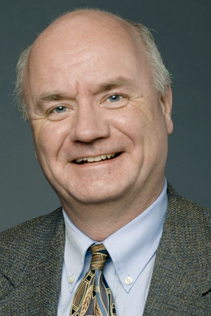Spring 2015
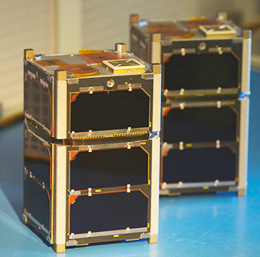 |
|
| FIREBIRD II |
The dual-satellite FIREBIRD II CubeSat mission that was launched in late January is performing beyond expectations reports Harlan Spence, UNH principal investigator on the mission. "Both spacecraft are doing an excellent job, the data quality are fantastic, and we're seeing everything we'd hoped for in terms of the microbursts and their associated structures." The 4x4x6-inch Focused Investigations of Relativistic Electron Burst Intensity, Range, and Dynamics CubeSats brave a region of space 400 miles above Earth to probe a mysterious physical process within our planet's dangerous radiation belts known as microbursts, which involves electrons moving at nearly the speed of light during 100-millisecond events. Microbursts are thought to be one of the primary mechanisms by which the outer radiation belt loses energetic particles to Earth's atmosphere after the occurrence of powerful solar storms. Such storms can dramatically change the intensity of the radiation belts and so FIREBIRD II is closely aligned with the twin-spacecraft Van Allen Probes mission that is currently orbiting in the same general vicinity and for which Spence also serves as a principal investigator. "During a second magnetic storm we encountered after launch of FIREBIRD II, all four spacecraft were close to each other and were able to look at waves and particles in a different way, and from those comparisons we can start learning about the physics of how particles are lost from the radiation belts to the atmosphere."
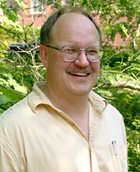 | |
| Jimmy Raeder |
Jimmy Raeder received funding from the Air Force Office of Sponsored Research to include data assimilation using an Ensemble Kalman Filter into his global magnetosphere model, known as Open Geospace General Circulation Model. The work will be performed in collaboration with Tomoko Matsuo at the University of Colorado Boulder and Jeff Anderson's Data Assimilation Research Testbed group at NCAR.
Raeder and his Ph.D. student Shiva Kavosi (first author) also had a paper published in Nature Communications titled “Ubiquity of Kelvin-Helmholtz waves at Earth’s magnetopause.”
Ph.D. candidate Jason Shuster recently published two papers in Geophysical Research Letters targeted at elucidating the outstanding mystery of magnetic reconnection central to NASA's Magnetospheric Multiscale (MMS) mission. Shuster is becoming more involved in efforts to process data that will be obtained from instruments on board the four MMS satellites. Since the successful MMS launch in early March, Shuster has been working alongside UNH researchers Matthew Argall and Rich Messeder to understand and develop data products for the UNH-built Electron Drift Instruments (EDI) for which Roy Torbert is principal investigator. Shuster's professional goal is to continue studying magnetic reconnection as a post-doctoral researcher and share discoveries from the "MMS Era" of plasma physics research with both professional and public audiences. Shuster also reports that he and fellow graduate student Fathima Muzamil recently gave a talk at Noble High School in North Berwick, Maine about MMS and magnetic reconnection.
For the MMS mission, Matt Argall notes that as a graduate student he analyzed data from the Cluster mission in an effort to frame questions that the MMS mission will be able to answer and created techniques that will allow MMS to better focus on its primary science objectives. With MMS now poised to begin its science phase, Argall will be responsible for creating and maintaining the merged data product and for some processing of the EDI data. “My work with simulations and data will also be ongoing, along the lines of MMS's primary mission objectives.”
Jichun Zhang was awarded $508K from NASA’s Heliophysics Guest Investigators Program for a three-year project titled “EMIC waves and associated relativistic electron precipitation.”
Ph.D. candidate Trevor Leonard reports that using data from Interstellar Boundary Explorer (IBEX) observations of the interstellar neutral (ISN) gas flow over the past six years, he and other IBEX team members have improved the determination of the ISN flow direction and speed. “Knowing the properties of the ISN flow is essential to understanding the interaction between the heliosphere and the interstellar medium.” The sun’s heliosphere shields us from galactic cosmic rays, which could make Earth uninhabitable, and changes in the interaction between the heliosphere and the interstellar medium can alter the effectiveness of this shielding.
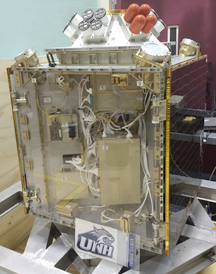 |
|
| CATSAT |
SSC senior project engineer Mark Granoff is leading an effort to open a new exhibit at the McAuliffe-Shepard Discovery Center featuring a small satellite built beginning in the late 1990s by Space Science Center faculty, staff, and students. The Cooperative Astrophysics and Technology SATellite, or CATSAT, was designed as a small, rapidly built, inexpensive space mission funded under the University Space Research Association’s Student Explorer Demonstration Initiative. Says Granoff, “For the exhibit, I am reaching out to former CATSAT colleagues to help us recall the story of the USRA STEDI program, and of UNH successfully competing to win the bid to built this satellite under the direction of former SSC professor David Forrest.” CATSAT former associate principal investigator Ken Levenson (now with Raytheon) is a key partner in the current effort to tell the CATSAT story. Granoff notes further that while the design and fabrication of CATSAT was fully realized, the little satellite never flew in space due to launch vehicle and risk limitations, but that CATSAT ultimately launched a large number of UNH students into successful, high-profile aerospace careers. “With a bit of sprucing up, CATSAT will be ‘flying high’ at the MSDC and we are looking forward to seeing CATSAT in this fitting place of honor in the near future.” Aerospacefest will be held Saturday, June 13 from 10:30 a.m. to 4 p.m. at the MSDC in Concord. Financial support for the effort is being provided by the Northern New England Section of the American Society of Mechanical Engineers, EOS/SSC, professor Eberhard Möbius, and the Sophron Foundation.
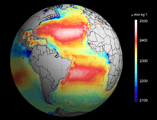 |
|
| Total ocean alkalinity from space. Photo courtesy of Ifremer/ESA/CMES |
In collaboration with colleagues in Europe, Joe Salisbury and Doug Vandemark coauthored a paper published in Environmental Science and Technology about how pioneering techniques that use satellites to monitor ocean acidification are poised to revolutionize the way marine biologists and climate scientists study the ocean. The new approach offers remote monitoring of large swathes of inaccessible ocean from satellites by using thermal cameras to measure ocean temperature and microwave sensors to measure salinity. Together, these can assess ocean acidification more quickly and over much larger areas than has been possible before via single-point, in situ measurements from research vessels. Among the satellites being used for the groundbreaking work are the European Space Agency's Soil Moisture and Ocean Salinity sensor and NASA's Aquarius satellite.
Jamie Pringle was funded by the National Science Foundation for a four-year, $370K project titled “Basin scale forcing of flows on western-boundary shelves.” Studies of the alongshore flow along western-boundary continental shelves have failed to explain why the mean flows exist. For example, along the east coast of North America from Cape Hatteras to the Labrador Sea, the waters flow to the southwest except when winds are strong enough to reverse the flow. Pringle’s research aims to find the causes of this average southwestward flow by linking it to the larger scale ocean basin circulation. He hypothesizes that these flows are not driven by phenomena over the continental shelves (winds, river inflows, etc.) but are instead driven by the winds over the entire ocean. If this hypothesis is supported by his modeling and observational data it will help the research community understand how global-scale changes in climate drive changes in the coastal flows around North America. The regional flows are important both locally—for example, they bring cold water down from the Labrador Sea and cool New England—and globally as they are an important pathway linking the high latitude oceans to temperate oceans.
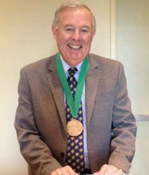 |
|
| Barry Rock |
Professor emeritus Barry Rock was selected by the Youth Learning as Citizen Environmental Scientists grant-making organization as the first recipient of its Youth Environmental Science Medal in recognition of his formative work in the development and implementation of inquiry-based, experiential K-12 science education. Rock is founding director of the UNH Forest Watch program, which since it began in 1991 has involved more than 350 schools across New England in K-12 student measurements and health assessments of white pine—a known bio-indicator species for exposure to ozone in the air. Rock was presented with the medal March 13 at the National Science Teachers Association National Annual Meeting in Chicago, Illinois.
Scott Ollinger received a new grant of $127K over three years from the Northeastern States Research Cooperative to study carbon cycling at the Bartlett Forest in the NH White Mountains.
Ph.D. candidate Jonathan Buzan of the Climate Dynamics Prediction Lab published his first paper in February with lab director Matt Huber as coauthor in Geosciences Model Development. Titled “Implementation and comparison of a suite of heat stress metrics within the Community Land Model version 4.5,” the goal of the work is to have a common predictive framework for measuring heat stress globally.
In April, former Ph.D. student Claire Treat coauthored on a paper published in Nature titled “Climate change and the permafrost carbon feedback.” Now a postdoctoral researcher with the University of Alaska and the U.S. Geological Survey in Menlo Park, California, Treat’s contribution was based on her dissertation work on carbon losses from permafrost soils under aerobic and anaerobic conditions.
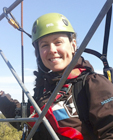 |
|
| Liz Burakowski |
Recent Ph.D. graduate and current EOS postdoc Liz Burakowski was lead author on a paper published in Remote Sensing of Environment titled “Spatial scaling of reflectance and surface albedo over a mixed-use, temperate forest landscape during snow-covered periods.” ESRC coauthors include Scott Ollinger, Lucie Lupine, Jack Dibb, and Mary Martin. Burakowski rejoined EOS as a postdoctoral researcher to work on a UNH (NH EPSCoR) project in cooperation with scientists at the National Center for Atmospheric Research. She will continue to reside at NCAR in Boulder, Colorado where she has been working since completing her Ph.D. at UNH last year.
Ph.D. student Alexandra Thorn was lead author on a paper published in Ecosphere titled “Generalization and evaluation of the process-based
forest ecosystem model PnET-CN for other biomes.” ESRC scientists Scott Ollinger and Jingfeng Xiao are coauthors. The other biomes are grasslands, shrublands, and savannas. The work was funded by the NSF MacroSystems Biology program.
Steve Frolking coauthored five papers on topics ranging from remote sensing of global crop production and seasonal dynamics of canopy-scale photosynthesis to simulation of water resources required for crop production in China.
Ph.D. candidate Danielle Grogan was lead author on a paper published in Science of the Total Environment titled “Quantifying the link between crop production and mined groundwater irrigation in China.” It is her first publication based on her dissertation. Says Grogan, “China, one of the world's ‘breadbaskets,’ has used irrigation to help expand and intensify its agricultural production over the past several decades. We modeled China's agricultural system to quantify irrigation water sources, and determine the sustainability of its irrigation water use. We found that nearly one third of China's irrigation water comes from unsustainable groundwater pumping and this unsustainable water source is directly responsible for approximately 20 percent of food produced in China annually. I am currently expanding the work in this study to look at unsustainable groundwater pumping for irrigation on a global scale.” ESRC coauthors on the paper include Alex Prussevitch, Richard Lammers, Dominik Wisser, Stanley Glidden, Changsheng Li, and Steve Frolking.
Michael Palace was first author on a paper titled “Estimating forest structure in a tropical forest using field measurements, a synthetic model and discrete return lidar data “ in Remote Sensing of Environment. Palace was coauthor on the paper “Tropical-Forest Biomass Estimation at X-Band from the Spaceborne TanDEM-X Interferometer” in IEEE Geoscience and Remote Sensing Letters.
 |
|
| Sun-to-Ice |
Erik Froburg and Ruth Varner note that the Leitzel Center serves as the education and outreach partner on the NSF-funded Sun-to-Ice project lead by EOS director Harlan Spence. Sun-to-Ice aims to investigate extreme solar events and their effects on Earth by detailed studies of each process in the chain from sun to ice, as energetic particles travel to Earth, enter our atmosphere, and ultimately collide with our planet. The Leitzel Center brings intensive STEM professional development to high school physics, chemistry, astronomy, and Earth and physical science teachers. Teachers are paired with Sun-to-Ice researchers or collaborators to explore a specific research topic. The resulting projects range from a high school teacher and student co-creating a capstone project to run a computer model that simulates deep dielectric charging on Mercury, to an entire class designing and testing instrument payload vehicles that can descend at a velocity so controlled that a raw egg in the payload will remain undamaged. Varner directs the Leitzel Center and Froburg is the center’s educational program coordinator.
Madeleine Mineau was awarded a Carsey School of Public Policy Summer Scholar Fellowship for the summer 2015 to do a project titled "Strahler stream order as a classification system in water policy: implications and alternatives.” Mineau will evaluate stream classification systems used in water policy with a focus on stream order and the Shoreland Water Quality Protection Act in NH.
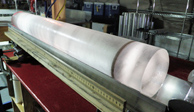 |
|
| WAIS Divide ice core Photo by Heidi Roop, NSF. |
Joe Souney and Mark Twickler of the West Antarctic Ice Sheet (WAIS) Divide Science Coordination Office at UNH were coauthors on the paper “Precise interpolar phasing of abrupt climate change during the last ice age” published April 30 in Nature. Twickler and Souney led the planning, logistics, and execution for the collection and processing of the WAIS Divide ice core.
